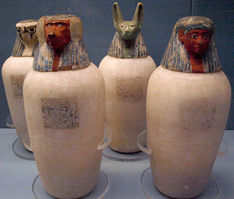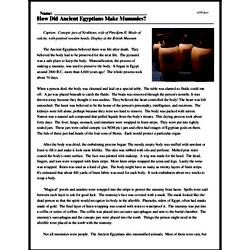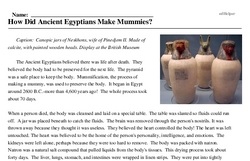How Did Ancient Egyptians Make Mummies?
Caption: Canopic jars of Neskhons, wife of Pinedjem II. Made of calcite, with painted wooden heads. Display at the British Museum
The Ancient Egyptians believed there was life after death. They believed the body had to be preserved for the next life. The pyramid was a safe place to keep the body. Mummification, the process of making a mummy, was used to preserve the body. It began in Egypt around 2600 B.C.-more than 4,600 years ago! The whole process took about 70 days.
When a person died, the body was cleansed and laid on a special table. The table was slanted so fluids could run off. A jar was placed beneath to catch the fluids. The brain was removed through the person's nostrils. It was thrown away because they thought it was useless. They believed the heart controlled the body! The heart was left untouched. The heart was believed to be the home of the person's personality, intelligence, and emotions. The kidneys were left alone, perhaps because they were too hard to remove. The body was packed with natron. Natron was a natural salt compound that pulled liquids from the body's tissues. This drying process took about forty days. The liver, lungs, stomach, and intestines were wrapped in linen strips. They were put into tightly sealed jars. These jars were called canopic (ca NOH pic) jars and often had images of Egyptian gods on them. The lids of these jars had heads of the four sons of Horus. Each would protect a particular organ.




